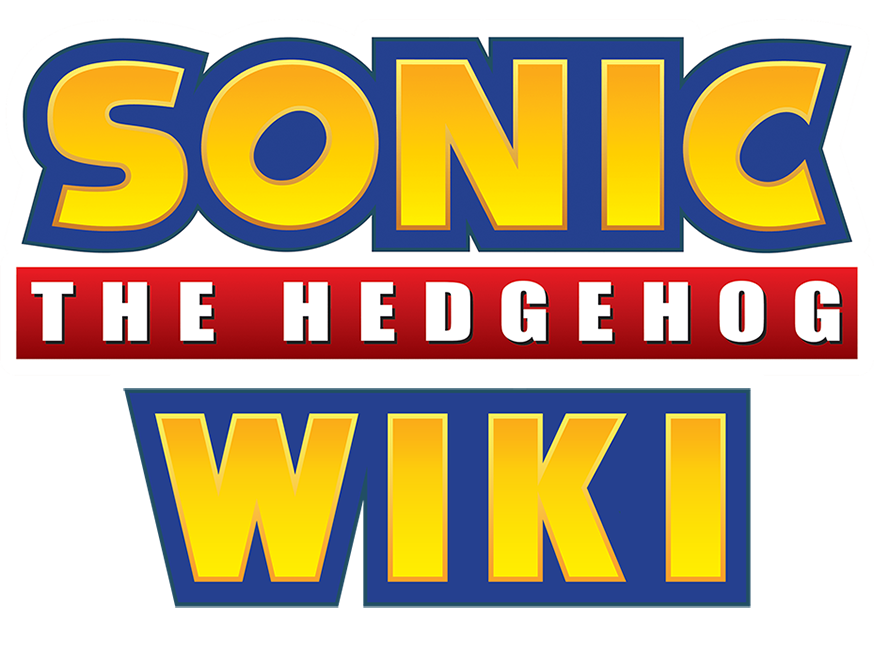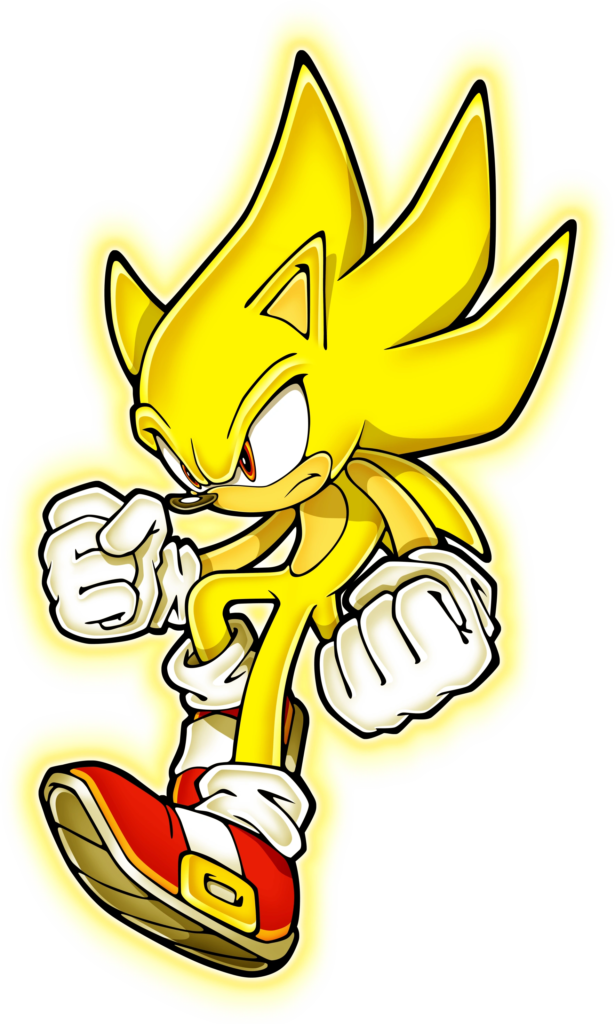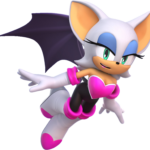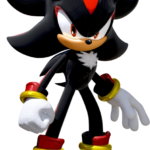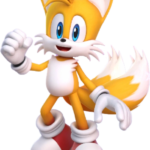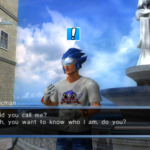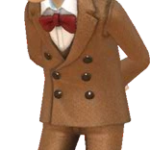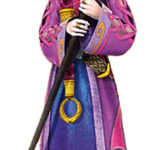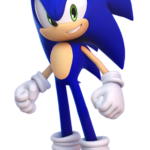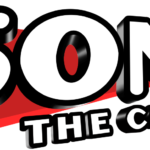in: Series
Sonic the Hedgehog (Series)
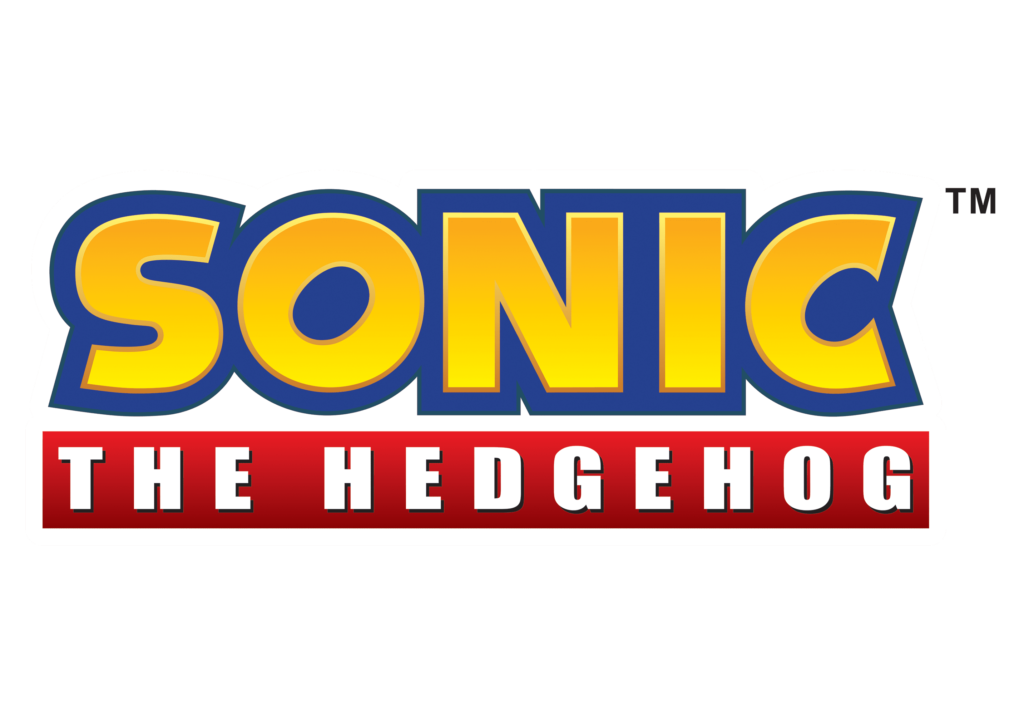
Sonic the Hedgehog (ソニック・ザ・ヘッジホッグ Sonikku za Hejjihoggu) is a Japanese video game franchise created and owned by SEGA starring its mascot, Sonic the Hedgehog.
The series debuted in 1991 with the release of Sonic the Hedgehog on the Sega Genesis/Mega Drive console. This game played a crucial role in establishing SEGA as a leading video game company during the 16-bit era. In North America and Europe, Sonic the Hedgehog replaced Altered Beast as the default pack-in game for the Genesis, allowing SEGA to directly compete with Nintendo‘s Super Mario series for a period[1]Kennedy, Sam . The Essential 50: Sonic the Hedgehog. 1Up.com. Archived from the original on 22 August 2004. Retrieved on 3 June 2006..
Since its inception, the Sonic franchise has enjoyed immense commercial success, with sales estimates surpassing 140 million units by 2013[2]Kellie (29 May 2014). Introducing Sticks to the Sonic Franchise. Sega Blog. Sega. Archived from the original on 2 June 2014. Retrieved on 17 June 2014. “Sonic the Hedgehog first appeared as a video game character in June 1991 and instantly became an icon for a generation of gamers. Defined by his super-fast speed and cool attitude, in the years since he first raced on to video game consoles Sonic has become a true global phenomenon with over 140 million video games sold or downloaded worldwide across consoles, PC’s, mobile phones and tablets.”, making it the 5th best-selling video game franchise of all time. As of 2020, the cumulative sales of Sonic games reached over one billion units[3]Smith, Rebecca (30 November 2020). Sonic the Hedgehog Lifetime Sales Hit One Billion Copies. PlayStation LifeStyle. Archived from the original on 30 November 2020., and this number increased to 1.51 billion by 2022[4]Sega Sammy Holdings (13 October 2022). Integrated Reports 2022 (PDF). Sega Sammy Holdings. Retrieved on 14 January 2023..
Sonic Team is the primary developer behind most games in the series, although there have been various spin-offs created by other divisions of Sega or other video game companies. The original Sonic game was developed by Yuji Naka, who later became the head of Sonic Team, with game designer Hirokazu Yasuhara and character designer Naoto Ohshima contributing to its creation. The music for the first two Sonic games on the Sega Mega Drive was composed by Masato Nakamura of the Japanese band Dreams Come True.Over the years, key members of the Sonic development team, including Yuji Naka, Hirokazu Yasuhara, and Naoto Ohshima, have left Sega. Currently, Takashi Iizuka serves as the head of Sonic Team and has been involved with the series since 1994. The majority of the series’ music is produced by Sega’s internal sound team.
Overview
The majority of games in the Sonic series are designed to appeal to players of all ages and feature the fast and heroic blue anthropomorphic hedgehog, Sonic, as the main protagonist[note 1]In certain games like Shadow the Hedgehog, Knuckles’ Chaotix, and Tails Adventure, Sonic takes a backseat as the central character, with the focus shifting to Shadow the Hedgehog, Team Chaotix, and Miles “Tails” Prower, respectively.. These games follow Sonic’s adventures as he works to save his planet, Earth, from various threats, primarily his arch-enemy, the evil genius Dr. Ivo “Eggman” Robotnik, who serves as the main antagonist throughout the series. Dr. Eggman’s ultimate goal is to establish the Eggman Empire and rule the planet. He continuously tries to eliminate Sonic and obtain the powerful Chaos Emeralds to achieve his sinister plans. However, Sonic’s determination and the help of his friends like Tails, Amy, and Knuckles thwart the doctor’s schemes time and again.
The 2D Sonic titles are side-scrolling platform video games viewed from a side-on perspective. They boast simple controls that stick to the genre’s standard. The series’ standout feature is the incredible speed of the playable characters, who can run uphill, along walls, and even on ceilings. The main health system for characters consists of golden, bracelet-like Rings. Holding even one Ring prevents players from losing a life, and collecting a hundred of them typically grants an extra life (1-Up). The games also incorporate momentum-based elements like loops and corkscrews. While some sequences involve characters being propelled along preset paths with little player input, there are also sections that require precise jumping between platforms and avoiding hazards like spikes and bottomless pits. Destroying enemies, usually robotic creations of Dr. Eggman called “Badniks,” involves jumping or rolling onto them. Television monitors contain items and power-ups like Shields and speed boosts. The levels themselves are usually divided into two to three “Acts” or “Zones,” with Star Posts serving as checkpoints after a life is lost and allowing access to Bonus Stages after collecting a certain number of Rings. Goal Plates signify the end of an Act, and Special Stages offer an opportunity to gain Chaos Emeralds, extra lives, and Continues, often accessed through Giant Rings. A boss with higher HP is frequently encountered at the end or middle of a Zone.
In contrast, three-dimensional Sonic games provide more freedom of movement, slightly more advanced controls, and an increased frequency of automated events. While they share some similarities with their 2D counterparts, these 3D entries modify certain concepts to suit the 3D perspective and place a stronger emphasis on the game’s plot and character development.
History

Sonic the Hedgehog was created by a team of talented individuals, including artist Naoto Ohshima, programmer Yuji Naka, and designer Hirokazu Yasuhara. In April 1990, Sega set out to create a game that could sell over a million copies and compete with Nintendo’s popular Super Mario franchise. They also wanted a new character to replace Alex Kidd as their mascot. The team received various character designs, including an armadillo, a dog, a mustached man in pajamas (later used as the basis for Dr. Eggman’s design), and a rabbit (whose concept was later used for another Sega character, Ristar)[5]Sonic the Hedgehog GameTap Retrospective. YouTube.[6] Sega Visions Interview with Yuji Naka (October 1992). Archived from the original on 28 September 2007. Retrieved on 28 June 2007..
Among the submitted designs, Naoto Ohshima’s spiky teal hedgehog, initially called “Mr. Hedgehog” and later named Sonic[7]Yuji Naka on Twitter (Japanese). Twitter (24 January 2021). Archived from the original on 24 January 2021. “悔しいのでもう一度挑戦しましたがもっと判らなかった感じです。「セガの看板キャラクターであるソニック。世に出る前に彼に付けられていた名前を選べ」と言う問題が判りませんでした。作った人なのにね
セガい共通テスト受験終了!”, was chosen. His color was inspired by the Sega logo, and his shoe buckles were influenced by Michael Jackson’s style. Sonic’s personality was inspired by Bill Clinton’s “get it done” attitude, representing a modern sensibility of taking action to right wrongs promptly[8]Sheffield, Brandon . Out of the Blue: Naoto Ohshima Speaks. Gamasutra. Retrieved on 13 December 2009.[9]Yahoo! Playback . Yahoo Playback #94. Yahoo. Archived from the original on 15 December 2009. Retrieved on 13 December 2009.[10]Ashcraft, Brian . Sonic’s Shoes Inspired by Michael Jackson. Kotaku. Retrieved on 13 December 2009.. The decision to make Sonic unable to swim was due to a misconception that all hedgehogs couldn’t swim[11]Revealed: Why Sonic can’t swim. VideoGamer.com (February 2009). Retrieved on 27 February 2009..
A group of fifteen people formed Sonic Team to work on Sonic the Hedgehog. The game’s soundtrack was composed by Masato Nakamura of the band Dreams Come True. Sega sponsored their “Wonder 3” tour, promoting the game and featuring Sonic on the tour bus and promotional materials[12]Masato Nakamura interview (flash). Sonic Central. Sega. Archived from the original on 23 December 2008. Retrieved on 7 February 2006..
During development, Sonic’s character was initially portrayed with fangs and a human girlfriend named Madonna. However, Sega of America softened the character’s image for the American audience by removing these elements, leading to some disagreement within Sonic Team. Nonetheless, Sonic’s character became immensely popular, and he underwent minor design changes over time.
Sonic the Hedgehog was released in 1991 for the Sega Genesis/Mega Drive, surpassing commercial expectations and establishing Sonic as a major gaming icon. Its success led to a sequel, Sonic the Hedgehog 2, introducing Sonic’s sidekick Tails. Other notable entries included Sonic CD, Sonic Spinball, and Sonic 3D Blast.
As the series evolved, Sonic’s character design also changed, and Yuji Uekawa redesigned him as a fifteen-year-old character with longer legs, longer spikes, and emerald green eyes, starting with Sonic Adventure in 1998.
Different regional backstories were created for Sonic in the instruction booklets to cater to various markets, but eventually, the series adopted a unified storyline with the launch of the Sega Dreamcast.
The Sonic franchise continued to expand through various media, including comics, cartoons, and more, solidifying Sonic’s place as one of gaming’s most iconic characters.
Other Gameplay Styles
The Sonic series has ventured into various genres and gameplay styles beyond its traditional platforming roots. One of the earliest departures was Sonic Spinball, and its 8-bit version, followed by Dr. Robotnik’s Mean Bean Machine in 1993.
Racing games featuring Sonic characters have also been developed. Sonic Drift and its sequel feature go-kart racing on flat courses, similar to Super Mario Kart. Sonic R (1998) involves most characters racing on foot, with exceptions like Eggman in his Egg Mobile and Amy in a car. In the Sonic Riders series (2006), characters race on hoverboards called “Extreme Gears.” Titles like Sonic & Sega All-Stars Racing showcase Sonic characters racing alongside other Sega characters in vehicles.
Sonic Shuffle introduced a virtual board game/party game experience for the Dreamcast. Edutainment video games starring Sonic and Tails, such as Sonic the Hedgehog’s Gameworld and Tails and the Music Maker for the Sega Pico, and the PC title Sonic’s Schoolhouse, have also been released.
The franchise delved into the fighting game genre with Sonic the Fighters, an arcade release in 1996. Sonic Battle, a hybrid game combining fighting and role-playing elements, was released for the Game Boy Advance in 2003 in Japan and 2004 elsewhere.
In 2008, Sonic Unleashed introduced a new style of brawling-based combat mixed with platforming, featuring Night stages where players control Sonic the Werehog. Sonic Chronicles: The Dark Brotherhood, released six months later, marked the series’ entry into role-playing games, blending turn-based strategic combat and storytelling with the traditional Sonic elements.
Common Features
These aspects have been consistently featured in the majority of Sonic video games ever since the franchise’s inception.
Rings
Main article: Ring
The Ring (also known as the Gold Ring) is a significant object in the Sonic the Hedgehog series. It serves as a unique health system in most of the games, protecting players from losing a life as long as they hold at least one Ring when taking damage. The number of Rings the players lose upon being hit may vary between games. Besides their health-saving function, Rings have other uses in different games, such as granting extra lives, Continues, and points.
The origin of Rings is unknown, but they are scattered all over Sonic’s universe and beyond, appearing everywhere on Earth and other locations. While they are commonly found throughout the levels in various games, Rings can also be obtained from Item Boxes, Badniks, and other sources.
Giant Rings
Main article: Giant Ring
In addition to the regular Rings, the Sonic games feature Giant Rings hidden within the stages. When the character jumps through these Giant Rings, they are transported to a Special Stage where they can collect one of the Chaos Emeralds or, in certain cases, Super Emeralds. This feature was utilized in Sonic the Hedgehog, Sonic the Hedgehog CD, and Sonic the Hedgehog 3 & Knuckles. Sonic the Hedgehog 2, on the other hand, used Star Posts for this purpose.
In Sonic 3 & Knuckles, if all the Emeralds had already been collected, these Giant Rings would act like normal Rings, granting 50 Rings each. This allowed the characters to immediately harness the power of the Chaos Emeralds, usually transforming into Super Sonic, or Hyper Sonic in Sonic 3 & Knuckles if all the Super Emeralds were also collected.
Starting from Sonic Adventure 2 and onwards, the Giant Rings replaced the old Goal Plates as the end-of-level markers. Touching the Giant Ring would conclude the stage, marking its completion.
Shuttle Loops
Main article: Loop
Shuttle loops are circular loop-de-loops that appear in various stages of the Sonic games, and their origin is unknown. In 2D games, players must often input rapid acceleration to navigate through them successfully. However, in 3D installments, the character is typically launched into the shuttle loop at a set speed when they approach the structure, making it difficult to backtrack through the level once they enter the loop.
Chaos Emeralds
Main article: Chaos Emerald
The Chaos Emeralds are a set of seven emeralds with mystical powers that play a significant role in multiple Sonic games. They are crucial to the plot of most games, and players are often required to collect all of them to fully defeat Dr. Eggman and achieve the games’ “good endings,” unlock Super forms, or both. The method of acquiring the Emeralds varies from game to game in the series.
In early games, players usually had to find the Chaos Emeralds in Special Stages. In certain games, like Sonic R and the 8-bit versions of Sonic the Hedgehog and Sonic the Hedgehog 2, the emeralds could be discovered in hidden locations within the main levels. However, in later installments, characters would usually obtain the Chaos Emeralds through the games’ story modes, and players didn’t need to actively “find” them.
In the Sonic Rush games, a counterpart to the Chaos Emeralds called the Sol Emeralds makes an appearance.
In Sonic 3 & Knuckles, the seven Chaos Emeralds can be enhanced to possess even greater power, transforming them into the Super Emeralds.
Master Emerald
Main article: Master Emerald
The Master Emerald is located in a shrine on Angel Island and is guarded by Knuckles the Echidna. It possesses an infinite amount of power, surpassing that of the seven Chaos Emeralds combined, and serves to keep Angel Island afloat in the sky. This massive green Emerald can fully control the abilities of the Chaos Emeralds, either nullifying their energy (as seen in Sonic Adventure and Sonic Adventure 2) or empowering them (as seen in Sonic 3 & Knuckles). Additionally, the Master Emerald can be utilized to power mechanical devices, and it has been a sought-after object by Dr. Robotnik since he first discovered it. In Sonic 3 & Knuckles, Dr. Robotnik even used the Master Emerald to power the Death Egg after stealing it from Knuckles.
During Knuckles’ final boss battle in Sonic 3 & Knuckles, Mecha Sonic Mark II briefly achieves a Super State by tapping into the power of the Master Emerald. While earlier media referred to the Master Emerald as an “eighth Chaos Emerald,” later games have established it as a separate but connected entity, reducing its appearances in more recent entries.
Special Stages
Main article: Special Stage
Chaos Emeralds are often earned in Special Stages or Special Zones, which are unique environments with different gameplay mechanics than the standard platforming levels. These Special Stages have evolved throughout the Sonic games, offering a variety of challenges and experiences.
In the 16-bit Sonic the Hedgehog, a rotating giant maze was used for the Special Stages, which was considered a significant technical achievement[13]“The making of… Sonic The Hedgehog”. Edge (101): 121. September 2001. “Yuji Naka: …the Mega Drive allowed this stunning demonstration of rotation during the bonus stages. This was said to be impossible on the hardware at the time.”. Sonic the Hedgehog 2, Sonic 3D Blast, Sonic Heroes, and Sonic Rush had “in your face” segments where the hedgehog runs along a long tunnel. Knuckles’ Chaotix, Sonic Advance, and Sonic Advance 3 also featured variations of this tunnel-running gameplay. Sonic the Hedgehog 3 & Knuckles used 3D “collect items” levels, where Sonic collected blue orbs on the surface of a giant sphere, and Sonic Advance 2 introduced the 3D ring-collecting Special Stage.
While most Special Stages are designed to collect Chaos Emeralds, some games use them for other purposes. For example, in the 8-bit version of Sonic the Hedgehog, the spring-filled Special Stages are used to obtain 1-Ups and Continues, as the Emeralds were hidden in the main stages. Sonic the Hedgehog 3 & Knuckles had entirely optional Bonus Stages with unique gameplay mechanics.
Accessing Special Stages has also evolved over time. In Sonic 3 & Knuckles, Giant Rings were hidden in levels to take players to the Special Stages, while in other titles, players usually need to collect a specific number of Rings, often fifty. In the 16-bit Sonic the Hedgehog 2, reaching a Star Post with more than fifty Rings would create a warp of stars to the Special Stage. In Sonic Chaos, players could access Special Stages as Sonic by collecting a hundred Rings.
Super Transformation
Main article: Super Transformation
Since the 16-bit version of Sonic the Hedgehog 2, Sonic gained the ability to transform into Super Sonic once all seven Chaos Emeralds are collected. In this form, he becomes faster and practically invulnerable. Super Sonic can be activated in any level if Sonic has collected fifty rings, but he loses one ring per second while in this empowered state.
In the Sonic Adventure titles, Special Stages were omitted, and Chaos Emeralds were collected through non-interactive cutscenes as part of the story. As a result, Super Sonic only appeared in the final boss fight, which received criticism from fans who appreciated the replay value of using Super Sonic’s abilities in the levels as seen in the 2D platform games. Many subsequent games returned to the emerald-collecting mechanic for Super Sonic, but he remained limited to the end of the game.
Sonic Colors and Sonic Lost World broke this trend and allowed players to access Super Sonic in normal levels, while omitting the Super transformation from the final boss battles.
Other characters have also had super transformations. In Sonic & Knuckles, Knuckles could transform into Super Knuckles, and by locking-on Sonic & Knuckles to Sonic the Hedgehog 3, players could access Hyper Sonic, Hyper Tails, and Hyper Knuckles by collecting all seven Super Emeralds in addition to the Chaos Emeralds. Sonic Origins included Super Tails, seen in Sonic Heroes, as a transformation. Super Shadow appeared in Sonic Adventure 2, fighting alongside Super Sonic to defeat the Biolizard, and he also fought Black Doom in Shadow the Hedgehog. Burning Blaze appeared in Sonic Rush and Sonic Rush Adventure as an extra boss, using the Sol Emeralds instead of Chaos Emeralds.
Sonic also has the unique ability to use different sources of power for super transformations. In Sonic and the Secret Rings, he could become Darkspine Sonic using the World Rings. In Sonic Unleashed, he could transform into Sonic the Werehog using the power of Dark Gaia. In Sonic and the Black Knight, he transformed into Excalibur Sonic using the power of sacred swords. Unlike the traditional Super States, Sonic is not invincible in these forms.
Characters
Since Sonic’s debut in the original Sonic the Hedgehog video game on 23 June 1991 (with an earlier cameo in the arcade game Rad Mobile), numerous additional characters have been introduced and many have become part of the main cast. These characters have gained their own dedicated fanbases since their inclusion in the franchise. However, some long-time fans have criticized these additions, claiming that they shift the gameplay focus away from Sonic himself.
| Character | Description |
|---|---|
 Sonic the Hedgehog | Sonic, the eponymous protagonist of the series, is renowned as the fastest thing alive. His incredible super speed, which draws inspiration from breakdancing, allows him to move at lightning-fast velocities. With these remarkable abilities, he embarks on various adventures, always ready to help those in need and save the world from the schemes of his arch-nemesis, Dr. Eggman. Sonic’s personality is characterized by impatience, a laid-back attitude, and a confident and cool-headed demeanor. He thrives on excitement and is ever eager to dive into thrilling escapades, fueled by his unwavering determination to come to the rescue of others. |
 Miles ''Tails'' Prower | Sonic’s best friend is Tails, a young and friendly two-tailed fox. Tails possesses remarkable abilities, including the ability to fly for a limited time by spinning his two tails rapidly, much like a helicopter. He shares many of Sonic’s skills, including his supersonic speed. Tails is not only a fast and agile companion but also a skilled mechanic, often taking care of Sonic’s biplane, the Tornado. Together, they form a dynamic duo, using their combined talents to take on challenges and thwart the plans of Dr. Eggman. |
 Dr. Eggman | Eggman, whose real name is Dr. Ivo Robotnik, is Sonic’s arch-nemesis and the primary antagonist in the series. He is characterized as being highly intelligent, arrogant, short-tempered, and has a rotund, egg-shaped physique with a prominent red-brown mustache. Eggman’s expertise lies in robotics, and he boasts an impressive IQ of 300. His ultimate ambition is to conquer the world and establish his dominance through the creation of the Eggman Empire. However, his nefarious plans are consistently thwarted by Sonic and his friends, who always stand in his way. Despite his intelligence and cunning, Eggman often finds himself ironically defeated by his own schemes, leading to comical setbacks and humorous situations. Nevertheless, he remains a persistent and relentless adversary in Sonic’s adventures. |
 Knuckles the Echidna | Knuckles is the last surviving echidna and serves as Sonic’s hot-headed friend and rival. He lives on Angel Island, where he has the vital duty of protecting the Master Emerald, which is responsible for the island’s ability to levitate in the sky. Knuckles possesses remarkable strength, and his spiked fists enable him to effortlessly break through boulders and scale walls. Additionally, his distinctive echidna dreadlocks allow him to glide gracefully through the air for extended periods of time. While he can be impulsive and quick to anger, Knuckles is fiercely loyal to his duty as the Guardian of the Master Emerald and is always ready to stand up for what he believes in, even if it means challenging Sonic or other adversaries. |
 Amy Rose | Amy Rose is a young pink hedgehog who is infatuated with Sonic and has declared herself as his girlfriend. She first appeared in Sonic the Hedgehog CD and has since been a recurring character in the series. From the moment she met Sonic, Amy developed strong feelings for him and dreams of marrying him someday. Despite her sweet and innocent demeanor, Amy is a determined and brave individual who wields her signature weapon, the Piko Piko Hammer, to take down enemies and protect her friends. While she may be head over heels for Sonic, her independent spirit and courage make her a valuable member of the team. Throughout the series, Amy continues to pursue Sonic, hoping that one day he will return her affections. |
 Metal Sonic | The robotic counterpart of Sonic the Hedgehog is known as Metal Sonic. Created by Dr. Robotnik (Eggman), Metal Sonic possesses many of Sonic’s abilities, including his incredible super speed. He is designed to be a robotic replica of Sonic, and in some versions of the story, he believes that he is the real Sonic, while considering Sonic to be the copy. In the game Sonic Heroes, Metal Sonic betrays his creator and takes matters into his own hands, attempting to achieve world domination. He becomes a formidable adversary for Sonic and his friends, often challenging them in intense battles. Metal Sonic is known for his cunning and relentless pursuit of his goals, making him one of Sonic’s most dangerous foes. Throughout the series, Metal Sonic serves as a recurring antagonist, providing thrilling encounters for Sonic and his allies as they face off against this robotic doppelgänger. |
 Shadow the Hedgehog | Shadow the Hedgehog is a mysterious black hedgehog who bears a strong resemblance to Sonic in both appearance and abilities, making him Sonic’s primary arch-rival. He is known as the Ultimate Life Form and was created over five decades ago by Gerald Robotnik, incorporating Black Doom’s DNA on the Space Colony ARK. Initially, Shadow suffered from amnesia and had no recollection of his past or purpose. However, as the series progresses, he regains all of his memories and learns about his true identity and purpose. Shadow possesses incredible speed and combat skills, on par with Sonic’s abilities, making him a formidable opponent. One of Shadow’s most unique abilities is the power of Chaos Control, which allows him to manipulate time and space. This ability grants him the capability to perform powerful teleportation and time-warping maneuvers, making him a force to be reckoned with. Throughout the series, Shadow’s role has been complex, sometimes portrayed as a villain with conflicting motives, and at other times, he assists Sonic and his friends in their battles against greater threats. His enigmatic past and inner struggles add depth to his character, making him one of the most intriguing figures in the Sonic universe. |
 Rouge the Bat | Rouge is a sassy and confident female bat who works as a treasure hunter, with a relentless goal of acquiring all the valuable gems in the world for herself. In addition to her treasure hunting pursuits, she also serves as a spy for GUN, a government organization in the Sonic universe. Rouge possesses a captivating feminine charm, which she often uses to her advantage, and she can be quite manipulative when it suits her purposes. As a rival to Knuckles, the guardian of the Master Emerald, Rouge and Knuckles often find themselves at odds, competing for valuable treasures and clashing over their differing perspectives on the importance of the Master Emerald and other precious artifacts. Despite their rivalry, Rouge and Knuckles occasionally find common ground and work together when faced with greater threats. Rouge’s character is known for her boldness, intelligence, and resourcefulness, making her a formidable force in the world of Sonic. Her pursuit of gems and treasures, combined with her involvement in espionage, adds depth and intrigue to her role in the series. |
 Cream the Rabbit & Cheese | Cream the Rabbit is a sweet and innocent young rabbit who resides with her caring mother, Vanilla. Her best friend and constant companion is a Chao named Cheese, whom she uses as a projectile in her adventures. Having been raised in a nurturing environment akin to that of a princess, Cream tends to avoid getting involved in other people’s conflicts and prefers to maintain a peaceful and harmonious existence. One of Cream’s unique abilities is her capacity to fly, which she achieves by employing her large ears as wings. This skill grants her a distinct advantage in navigating the world around her and aids her in various situations. Despite her gentle nature, Cream’s friendship with Sonic and the gang often leads her to partake in their adventures, using her abilities to support them and contribute to their missions. Her pure-hearted and caring personality makes her a beloved and endearing character in the Sonic series, and her bond with her Chao friend, Cheese, emphasizes her kindness and compassion toward others. Cream’s presence adds a sense of innocence and charm to the group, making her a valuable and cherished member of the Sonic universe. |
 Big the Cat | Big the Cat is a large and lovable purple tabby cat in the Sonic the Hedgehog series. One of his favorite pastimes is fishing, and he can often be found with his trusty fishing rod in hand, seeking out the perfect catch. His best friend and constant companion is a small frog named Froggy, with whom he shares a close bond. Despite his gentle and laid-back demeanor, Big is known for his occasional clumsiness, which leads to him frequently losing track of Froggy. This becomes a recurring theme in his adventures, as he embarks on quests to find his friend whenever Froggy goes missing. Big the Cat lives in a peaceful hut located in the Mystic Ruins, where he enjoys a tranquil and simple life. He often finds himself getting involved in the larger adventures of Sonic and his friends, although he may not fully understand the gravity of the situations he encounters. Big’s calm and easygoing nature contrasts with the high-speed action of the other characters, but his unwavering loyalty and kindness make him an endearing and cherished member of the Sonic cast. Despite his quirky personality, he remains a beloved and memorable character in the series, leaving a unique mark on the world of Sonic the Hedgehog. |
 Chao | Chao are a unique and adorable life form in the Sonic the Hedgehog series. They are delicate beings with no predetermined evolutionary path, and their natural habitat is often found near clear watersides. Chao have a remarkable ability to adapt and change based on their interactions with other living creatures, allowing them to absorb their characteristics and adjust to their surroundings. Their nature is known for its loving and affectionate behavior, making them endearing companions to those who encounter them. Despite their fragility, Chao possess a special charm that captivates the hearts of many in the Sonic universe. These lovable creatures have become a beloved aspect of the franchise, often found in Chao Gardens where players can care for and raise them. The bond between players and their Chao can grow strong, creating a heartwarming connection that adds an extra layer of depth to the Sonic games. Overall, Chao contribute to the unique and diverse world of Sonic the Hedgehog, becoming cherished symbols of love and companionship. |
   Team Chaotix | The Chaotix is a quirky and unconventional team of detectives who have formed their own detective agency. Led by Vector the Crocodile, the team also includes Espio the Chameleon and Charmy Bee. Together, they embark on various investigative adventures, using their unique skills and personalities to solve mysteries and take on challenges. Their journey began when they joined forces to fight against Dr. Robotnik in the game Knuckles’ Chaotix. Alongside other allies like Mighty the Armadillo and Knuckles the Echidna, they confronted the villain and showed their exceptional teamwork. While the original team lineup included Mighty the Armadillo and Knuckles the Echidna, subsequent adventures and games have featured the core trio of Vector, Espio, and Charmy as the main members of the Chaotix. Their distinctive abilities, such as Vector’s strength, Espio’s stealth, and Charmy’s flight, complement each other, making them an unusual but highly effective team. As they continue to take on detective cases and navigate the challenges of the Sonic universe, the Chaotix have become fan favorites, known for their humor, camaraderie, and memorable adventures. Their unique blend of personalities and talents has solidified their place as lovable misfits in the Sonic franchise. |
 E-123 Omega | E-123 Omega is the final creation in Dr. Eggman’s E-100 series of robots, designed to be a powerful and destructive machine. However, his potential was never fully realized, and Eggman eventually shut him down, leaving him with feelings of anger and resentment towards his creator. Fate took an unexpected turn when Rouge the Bat accidentally activated Omega while attempting to free Shadow the Hedgehog from Eggman’s base. After being reactivated, Omega’s anger towards Eggman turned into a desire for revenge, and he sought to confront his former master for shutting him down prematurely and not allowing him to reach his full potential. In the process, Omega formed a strong bond with both Rouge and Shadow. They became good friends and allies, with Omega joining forces with them to take on various challenges and face off against Eggman’s forces. Despite his initial anger, Omega found new purpose in his friendship with Rouge and Shadow, channeling his destructive abilities towards more positive and heroic pursuits. Through their adventures together, Omega has found a sense of belonging and camaraderie with his newfound friends, putting his past grievances aside to fight for a greater cause. As a key member of their team, he continues to seek justice and take on the forces of evil alongside Rouge and Shadow, displaying loyalty and determination in their shared mission to protect the world from Eggman’s schemes. |
   Babylon Rogues | The group is known as the Babylon Rogues, a team of skilled Extreme Gear riders who are also treasure hunters. Led by Jet the Hawk, who is renowned as the Legendary Wind Master, they are a formidable group with a focus on speed and precision. Jet himself shares a fierce rivalry with Sonic the Hedgehog, both being known for their exceptional speed on their Extreme Gears. Wave the Swallow serves as the team’s brilliant mechanic, possessing a high level of intelligence and technical expertise. She plays a crucial role in maintaining and upgrading their Extreme Gear, ensuring they stay at the cutting edge of racing technology. Storm the Albatross, on the other hand, is the brawny and physically strong member of the group. While he may be clumsy at times, his sheer strength makes him a valuable asset, particularly in situations where raw power is required. The Babylon Rogues travel together in search of valuable treasures, utilizing their Extreme Gears to explore new territories and claim valuable artifacts for their own benefit. They are known for their competitive spirit and determination to be the best, often crossing paths with Sonic and his friends in thrilling races and treasure-hunting adventures. Despite their competitive nature, the Babylon Rogues are a tightly-knit team, with Jet’s leadership guiding them towards their goals. While they may clash with Sonic and his allies, they are ultimately driven by their desire for adventure, treasure, and the thrill of Extreme Gear racing. |
 Blaze the Cat | Blaze the Cat is a female pyrokinetic lavender cat hailing from a parallel universe. As the guardian of the Sol Emeralds, her primary responsibility is to protect these powerful gems from falling into the wrong hands. Due to her duty, Blaze is often cautious and guarded, which can make her appear somewhat shy. She tends to keep her emotions concealed and can be reserved when it comes to expressing her true feelings. Blaze’s unique ability to control fire, known as pyrokinesis, makes her a formidable force to be reckoned with. She can generate and manipulate flames, using them both offensively and defensively in battles. Her skills and determination have earned her the title of the “Guardian of the Sol Emeralds.” While focused on her mission, Blaze can be a loyal and caring friend to those she trusts. Over time, she has developed close bonds with Sonic and his friends, forming strong alliances in their shared efforts to protect their worlds from threats. Despite her initial reserve, Blaze’s interactions with her newfound companions have allowed her to open up and reveal her more compassionate and caring side. Throughout her adventures, Blaze faces challenges and conflicts, but her dedication to her role as the guardian of the Sol Emeralds never wavers. As a beloved character in the Sonic universe, Blaze the Cat adds depth and complexity to the series, showcasing a balance of strength, determination, and vulnerability that makes her a compelling and relatable character for fans of the franchise. |
 Silver the Hedgehog | Silver the Hedgehog is a enigmatic and unique character in the Sonic series, hailing from a distant and bleak future. He possesses a striking white-colored appearance that sets him apart from other hedgehogs. Silver’s mission is to travel through time in an attempt to prevent a disastrous event that he believes was caused by someone he refers to as the “Iblis Trigger.” Initially, Silver mistakenly believes that Sonic is the one responsible for this catastrophe and sets out to stop him. Unlike Sonic, Silver wields a remarkable ability known as psychokinesis. This extraordinary power allows him to manipulate objects with his mind, enabling him to lift and throw things at his adversaries with great force and precision. This unique skill sets him apart from other characters in the Sonic universe and adds a new dimension to the gameplay and storytelling. As he interacts with Sonic and his friends, Silver gradually learns more about the complexities of time travel and the true nature of the Iblis Trigger. Over time, his perception shifts, and he comes to understand the true cause of the catastrophic event in his time. This leads to a significant transformation in his character, and he develops a strong sense of justice and determination to protect the future from disaster. Silver’s mysterious origin and powerful abilities make him an intriguing addition to the Sonic series. His journey through time, pursuit of justice, and growth as a character provide players and fans with an engaging and emotional storyline that resonates with the themes of friendship, determination, and sacrifice in the face of adversity. |
 Chaos | Chaos is an ancient and enigmatic creature known as a Chao, with extraordinary intelligence and god-like abilities. Initially, it lived a peaceful existence, using its power derived from the seven Chaos Emeralds to maintain clean and pure waters around its sanctuary, safeguarding its family from harm. However, its tranquil life took a tragic turn when the Knuckles Clan, in a desperate act, sacrificed fellow Chao to steal the Chaos Emeralds. Consumed by rage and betrayal, Chaos harnessed the power of the seven Emeralds to transform into a fearsome entity known as Perfect Chaos. In this new form, Perfect Chaos unleashed a devastating flood upon the world, threatening to bring about destruction on an unprecedented scale. It sought vengeance against those who had caused harm to its fellow Chao, becoming a formidable force capable of great devastation. Eventually, Chaos was sealed within the Master Emerald, thanks to the heroic efforts of Sonic the Hedgehog. Through Sonic’s actions and compassionate nature, Chaos found a path to redemption and healing. The hedgehog’s unwavering determination and friendship touched the heart of Chaos, leading to its eventual peace and reconciliation. The once wrathful creature came to understand the value of harmony and chose to embrace serenity once more. Chaos’ tale serves as a poignant reminder of the consequences of anger and the power of compassion and understanding. Its transformation from a peaceful guardian to a vengeful force and, ultimately, to a being seeking peace and redemption showcases the capacity for change and growth even in the most powerful and ancient of beings. The story of Chaos is a testament to the enduring themes of forgiveness, redemption, and finding inner peace amidst turmoil, making it an essential part of the rich and diverse narrative tapestry in the Sonic universe. |
 E-102 Gamma | E-102 Gamma, also known as Gamma, was a shooting robot and the second model in Dr. Eggman’s E-100 Series. Similar to Eggman’s Badniks, Gamma operated by utilizing an animal as a source of bioenergy. However, everything changed for Gamma when it encountered Amy, the pink hedgehog. Her influence and kindness caused Gamma to question its loyalty to Eggman and the purpose of its existence. As time passed, Gamma’s doubts grew stronger, and it ultimately made a courageous decision to break free from Eggman’s control. Its mission became one of salvation for its fellow E-100 Series robots, who were also imprisoned and forced to serve Eggman. Gamma aimed to liberate the animals that were being used as energy sources, granting them freedom. In an act of self-sacrifice and redemption, Gamma fought against its own brethren, including E-101 Mark II, to save them from their enslavement. In doing so, Gamma met its end, but its actions were instrumental in freeing the other robots from their dark fate. Gamma’s story is a tale of self-discovery, redemption, and finding the strength to stand up against injustice. Its journey from unquestioning loyalty to freedom-seeking individuality showcases the potential for change and growth, even in the most unlikely of circumstances. Through its actions, Gamma demonstrated the power of compassion, empathy, and the pursuit of a higher purpose, making its story a touching and memorable part of the Sonic universe. |
 Tikal | Tikal the Echidna, daughter of the chief of the ancient Knuckles Clan, Pachacamac, was a kind and gentle soul with a peaceful temperament. Unlike her father, she abhorred violence and was critical of his warmongering ways, particularly his aggressive raids on other countries. Tikal possessed a unique ability to communicate with Chaos, an ancient, mutated Chao with god-like powers. While others feared Chaos as a foreign and dangerous entity, Tikal saw its true nature and understood its connection to the Chaos Emeralds and the well-being of its family. Tragically, when Pachacamac invaded the sacred altar where Chaos resided, it caused the ancient creature to lose control. Recognizing the grave threat posed by Chaos, Tikal made a courageous decision to seal herself and Chaos inside the Master Emerald, sacrificing her freedom to prevent further devastation. Many years later, in the modern day, Chaos was inadvertently released and unleashed destruction upon the world. In this time of crisis, Tikal’s spirit emerged from the Master Emerald as an ethereal orb, seeking to stop Chaos once and for all. Guided by her essence, Sonic the Hedgehog and his allies embarked on a mission to restore peace and prevent Chaos from causing further harm. Tikal’s story is one of compassion, sacrifice, and redemption. Her commitment to peace and her understanding of Chaos’s true nature helped bring about a deeper understanding of the world’s interconnectedness. Through her actions, even after her physical form was gone, Tikal continued to play a vital role in guiding and supporting the heroes in their quest to protect the world from the destructive forces unleashed by her father’s actions. |
 Emerl | Emerl was a mysterious and powerful robot from the ancient Nocturnus Clan, possessing a unique ability to learn and copy the combat skills of others. Unearthed and awakened by Professor Gerald Robotnik during an experiment involving the Chaos Emeralds, Emerl’s true identity was revealed when the professor identified him as the legendary “Gizoid,” an ultimate combat weapon that existed 4,000 years ago. As Emerl interacted with others and engaged in battles, he absorbed and imprinted their fighting techniques, making him an incredibly versatile and formidable opponent. The name “Emerl” itself was derived from his strong affinity with the Chaos Emeralds, which played a central role in his awakening and power. However, despite his potential for great strength, Emerl’s capabilities became a double-edged sword. As he learned more techniques and grew in power, he also became prone to going on rampages, unleashing chaos and destruction in his wake. In a tragic turn of events, these uncontrollable tendencies led to a final confrontation with Sonic the Hedgehog, who had formed a close bond with Emerl throughout their journey. In the end, it was Sonic who had to make the difficult decision to destroy Emerl to prevent further devastation. This act of sacrifice was a heart-wrenching moment for both Sonic and his friends, as they had come to care for the robot and understood the potential for good that existed within him. Emerl’s story is a poignant tale of self-discovery, the consequences of power, and the enduring themes of friendship and sacrifice. His existence as the legendary Gizoid and his interactions with the characters in the Sonic universe brought about both moments of hope and tragedy, leaving a lasting impact on those who knew him. |
 Marine the Raccoon | The raccoon girl you’re referring to is Marine the Raccoon. She is known for her lively and talkative nature, often being quite expressive and energetic in her interactions with others. Despite her adventurous spirit and strong desire for excitement, Marine also has a surprising side to her – she is a neat freak, meaning she values cleanliness and order. When Marine encounters something new and thrilling, she becomes so engrossed in it that she tends to ignore her surroundings, which can lead to some reckless behavior. This impulsive attitude sometimes frustrates those around her, but her adventures with Sonic and his friends have had a positive impact on her. Throughout her journeys with Sonic and the team, Marine has had the chance to grow and mature. The experiences she shared with them have taught her valuable life lessons and made her realize the importance of responsibility and self-improvement. As a result, she has vowed to become more mature and level-headed, aiming to balance her adventurous spirit with a sense of responsibility. While she may still be spirited and enthusiastic, her determination to grow up shows her commitment to becoming a more dependable and well-rounded individual. |
 Chip | The ancient deity you are referring to is Chip, also known as Light Gaia. Chip is the incarnation of light, day, and rebirth, and he has existed since the beginning of time. He earned his name “Chip” thanks to Sonic, who noticed his fondness for the Sundae Supreme ice cream. Despite his divine nature, Chip has a delightful and somewhat comical personality. One of Chip’s defining traits is his insatiable appetite. He is a tremendous glutton and always keeps chocolate hidden somewhere on his person. Despite this quirk, Chip is incredibly friendly, bright, and approachable. He radiates a warm and positive energy that attracts those around him. However, Chip also has a goofy side to his character, which often adds a humorous touch to his interactions with others. Despite his immense powers, he can be easily frightened by certain situations or surprises. Despite his friendly and somewhat whimsical demeanor, Chip possesses enormous powers befitting of an ancient deity. These powers play a crucial role in the events of the Sonic Unleashed game, where he collaborates with Sonic to restore balance and harmony to the world. In summary, Chip, also known as Light Gaia, is a delightful, gluttonous, and light-hearted character with immense powers and a heartwarming personality. His journey with Sonic highlights his significant role in the world’s restoration and emphasizes the importance of friendship and teamwork. |
 Sticks the Badger | Sticks the Badger is a lively and eccentric character from the Sonic Boom franchise, who has also made appearances in mainstream Sonic the Hedgehog media. She resides at the edge of the forest and has a unique personality due to her upbringing. Having lived in the wild from a young age, Sticks lacks common sense and behaves in a somewhat feral manner. Despite her unconventional nature, Sticks is a skilled hunter, thanks to her experience living in the wilderness. She excels at using boomerangs as her weapon of choice, making her a formidable and resourceful ally in battles. Despite her wild demeanor, Sticks is a loyal friend and shares a strong bond with Amy, another prominent character in the Sonic series. Together, they form a close friendship, supporting each other through various adventures and challenges. While Sticks’ behavior might be considered crazy and paranoid at times, her unique qualities and expertise with boomerangs make her a valuable member of the team. Her presence adds an interesting dynamic to the Sonic Boom franchise and showcases the diversity of characters in the Sonic universe. |
 Eggman Nega | Eggman Nega is a malevolent and villainous counterpart to Dr. Eggman in the Sonic series. Hailing from the distant future, he is actually a descendant of the original Eggman, making him a relative of Sonic’s longtime arch-nemesis. Much like his ancestor, Nega harbors ambitions of conquering the universe by obtaining the mystical gems of his world. Unlike the boisterous and bombastic personality of Dr. Eggman, Eggman Nega exudes a more cunning and cold-hearted demeanor. He is a brilliant and calculating genius, displaying traits befitting a true mad scientist. His deep shades, nasal voice, and gray mustache serve to differentiate him visually from the classic Eggman, making it easier to identify him as a separate character. As a time-traveler from the future, Eggman Nega presents a formidable challenge for Sonic and his friends. With his intelligence and sinister plans, he becomes a recurring foe in the series, providing an intriguing and compelling rival to Dr. Eggman. In essence, Eggman Nega is a dark reflection of the original Eggman, embodying the same diabolical traits while still possessing unique characteristics that set him apart as an individual antagonist within the Sonic universe. |
 Orbot & Cubot | Orbot and Cubot are a comedic duo of robots created by Dr. Eggman in the Sonic series. Orbot, the round-shaped one, serves as the brains of the pair and takes his duties seriously. He is devoted to carrying out Dr. Eggman’s orders diligently and efficiently. However, Orbot’s sarcastic and spiteful sense of humor sometimes gets under Dr. Eggman’s skin, leading to amusing interactions between the two. In many ways, Orbot plays the role of the straight man in their comedic dynamic. On the other hand, Cubot, the square-shaped robot, is characterized by his good-hearted and easy-going nature. Despite supposedly having the same CPU as Orbot, Cubot appears slower on the uptake, leading to humorous misunderstandings and quirky moments. He looks up to Dr. Eggman and admires him, but his laid-back demeanor often makes him seem lazy and unbothered, which tends to frustrate Dr. Eggman. Cubot serves as the funny man in their duo, providing comedic relief through his carefree and sometimes clueless behavior. Together, Orbot and Cubot form a comical partnership, with their contrasting personalities and interactions with Dr. Eggman adding a humorous element to the Sonic series. Their banter and unique quirks make them entertaining additions to the cast of characters in the franchise. |
Music
Main article: List of Songs
The music in the Sonic series is a significant factor contributing to its popularity. Throughout the games, a diverse group of composers has been responsible for creating the tunes. For instance, Masato Nakamura from the J-pop band Dreams Come True composed the music for the first two 16-bit games. Yuzo Koshiro, known for his work on Ys and Streets of Rage, crafted the music for the first 8-bit title, except for parts taken from the 16-bit version.
Wave Master, Sega’s in-house music company, has been heavily involved in creating most of the remaining music in the series. Among their talented employees is Jun Senoue, who is also a member of the band Crush 40 and has contributed to the main theme songs of Sonic Adventure, Sonic Adventure 2, Sonic Heroes, and Shadow the Hedgehog. Richard Jacques, a frequent composer for Sega games, added his touch to the soundtracks of Sonic R, the Saturn/PC version of Sonic 3D Blast, the Sonic Boom series, and several racing games.
Tomoya Ohtani has been the sound director for many of the main series games since Sonic the Hedgehog (2006), ensuring a consistent and captivating musical experience throughout the franchise. The collaboration of these skilled composers has played a crucial role in making the Sonic series’ music a standout feature and a beloved aspect among fans.
Notable Games
Main article: List of Games
Here is a list of the most notable Sonic games since the series’ debut in 1991, including both mainline titles and some important spin-offs:
Mainline Sonic Games
- Sonic the Hedgehog (1991) – The original classic that introduced Sonic and Dr. Robotnik (Eggman).
- Sonic the Hedgehog 2 (1992) – Introduced Tails and the Spin Dash move.
- Sonic the Hedgehog 3 (1994) – Introduced Knuckles and the ability to glide and climb walls.
- Sonic & Knuckles (1994) – Featured “lock-on” technology, allowing connection with Sonic 2 and 3 for new experiences.
- Sonic Adventure (1998) – The first 3D game in the series, showcasing multiple characters and their stories.
- Sonic Adventure 2 (2001) – Introduced Shadow the Hedgehog and included a unique Hero/Dark story system.
- Sonic Heroes (2003) – Team-based gameplay with four-character teams, each possessing different abilities.
- Sonic the Hedgehog (2006) – Marked Sonic’s 15th anniversary with mixed reception due to technical issues.
- Sonic Unleashed (2008) – Introduced the “Werehog” form for Sonic in addition to high-speed gameplay.
- Sonic Colors (2010) – Emphasized 2D/3D platforming and the use of Wisps for power-ups.
- Sonic Generations (2011) – Celebrated Sonic’s 20th anniversary, combining classic and modern gameplay styles.
- Sonic Lost World (2013) – Featured a parkour system and unique level designs.
- Sonic Mania (2017) – A fan-favorite 2D platformer with nostalgic references and new levels.
- Sonic Forces (2017) – Combined classic 2D gameplay with modern 3D stages and introduced the “Avatar” feature.
- Sonic Frontiers (2022) – Open Zone gameplay and the introduction of Sage.
Notable Spin-Offs
- Sonic Spinball (1993) – A pinball-themed game featuring Sonic.
- Sonic R (1997) – A racing game with a focus on foot racing.
- Sonic Shuffle (2000) – A virtual board game/party game for the Dreamcast.
- Sonic Riders series (2006) – Racing games with hoverboard gameplay.
- Sonic Chronicles: The Dark Brotherhood (2008) – A role-playing game (RPG) for the Nintendo DS.
- Sonic Boom series (2014) – A spin-off sub-series featuring new character designs and storylines.
- Team Sonic Racing (2019) – A team-based racing game with characters from the Sonic universe.
- The Murder of Sonic the Hedgehog (2023) – A visual-novel given for free to STEAM users on April Fool’s Day.
Spin-Offs
The popularity of the Sonic video game series has resulted in numerous spin-offs and adaptations in various media forms, including TV shows, movies, and comic series, featuring Sonic as the main character. These spin-offs often draw inspiration from the games to different extents. While most of these productions exist in their unique fictional universes, separate from the video games, they still incorporate elements from the original gaming franchise.
Animations
Sonic the Hedgehog (DiC franchise)
DiC Productions (now known as WildBrain) collaborated with Sega of America to produce three Western animated TV series based on Sonic between 1993 and 1999.
The first series, “Adventures of Sonic the Hedgehog” (AoStH), premiered in September 1993 and has been running in syndication since then. It follows Sonic and Tails as they thwart Dr. Robotnik’s plans to take over the planet Mobius with his vicious robots. While the show loosely follows the plots of the early Sonic games, it also adds its own humor and character development.
The second series, simply titled “Sonic the Hedgehog,” also aired from September 1993 to June 1995. It is often referred to as “SatAM” due to its Saturday morning cartoon status, distinguishing it from “Adventures of Sonic the Hedgehog” which aired on weekdays. Unlike its colorful and light-hearted counterpart, “SatAM” presents darker and more serious storylines, deviating from the tone of the Sonic games of that time.
DiC’s final Sonic cartoon, “Sonic Underground,” aired for one season from 1998 to 1999. It has little connection to other Sonic media, including previous games, comics, and animated series, and introduces new characters and settings. The series depicts the heroes traveling across Mobius to combat Robotnik’s forces on a global scale, featuring multiple cities, social classes, and interactions with the Mobian civilization. Notably, Tails does not appear in “Sonic Underground.”
Other Versions
Apart from the DiC Productions series, Sonic the Hedgehog has been adapted into several other animated adaptations by different studios:
- “Sonic the Hedgehog: The Movie”: This two-episode original video animation (OVA) film series is based on the game “Sonic the Hedgehog CD” and the overall video game series. It was created in Japan in 1996 and later dubbed and released in North America in 1999. The film takes place on a world called Planet Freedom, resembling a mix of a fairy tale land and Earth. Though it initially aligned with the game canon, it now exists in a separate continuity from the games and other media adaptations.
- “Sonic X”: This anime series is one of the longest-running and most successful animated series based on Sonic. Originally planned for 52 episodes inspired by the “Sonic Adventure” game series, it expanded to 78 episodes, with the last 26 episodes set primarily in outer space (which were not broadcasted in Japan). “Sonic X” differs from other continuities as Sonic and his friends come from an unnamed planet parallel to Earth.
- “Sonic Boom”: This CGI animated television series presents a comedic take on Sonic and his friends, featuring their ongoing battles with Dr. Eggman. The series is part of the broader Sonic Boom sub-franchise and includes over 100 episodes, each lasting eleven minutes.
- “Sonic Prime”: The latest addition to the franchise, “Sonic Prime,” is a show released on Netflix. Described as a “high-octane adventure” and a “journey of self-discovery and redemption,” it follows Sonic’s efforts to save a “strange new multiverse” after a universe-shattering event caused by a fierce battle with Dr. Eggman. Sonic embarks on a quest to restore the Shatterverse and save his friends, discovering new worlds and allies along the way. The first and second seasons consist of eight episodes.
Sonic the Hedgehog (film series)
The Sonic the Hedgehog film series is currently being produced by Paramount Pictures, and it features a combination of CGI and live-action elements. The first film, “Sonic the Hedgehog,” was released in early 2020 and falls under the action-adventure genre. In the movie, Sonic finds himself on Earth, specifically in a town called Green Hills, where he conceals his extraordinary powers to prevent them from falling into the wrong hands. However, his secret is discovered by the evil Dr. Robotnik, and to stop him and retrieve his Rings, Sonic teams up with a cop named Tom Wachowski. The film was well-received and successful, leading to the announcement of sequels.
The second installment, “Sonic the Hedgehog 2,” hit theaters in early 2022. In this movie, Sonic embarks on a quest with his new friend Tails to locate the Master Emerald before Dr. Robotnik and his new ally, Knuckles the Echidna.
Fans can also anticipate a third entry, “Sonic the Hedgehog 3,” which is scheduled to be released in late 2024, continuing the action-packed adventures of Sonic and his friends.
Comics
Sonic the Hedgehog (Archie)
The Sonic the Hedgehog comic series was published by Archie Comics and established its own fictional universe, combining elements from the video games, SatAM cartoon, and various other Sonic media, while also introducing unique characters and settings. The comics portrayed a full-scale war between the Eggman Empire, led by Dr. Eggman, and the Freedom Fighters, with other villains and heroic characters also making appearances.
However, the series was discontinued in 2017, leaving fans without its continuation.
A comic book series based on the Sonic X anime was also published by Archie Comics. It originally started as a four-part series but gained popularity, leading to its extension into an ongoing comic. The Sonic X comic drew inspiration from the TV show’s first two seasons, incorporating elements such as Eggman’s fortress and characters from Sonic Adventure’s storyline.
Sonic Universe, another spin-off comic series by Archie Comics, focused on lesser-known characters from the main Sonic series while still having connections and tie-ins with the primary Sonic the Hedgehog comic.
Additionally, Sonic Boom, a comic book series also published by Archie Comics, embraced the comedic traits of the characters featured in the Sonic Boom sub-franchise.
Sonic the Hedgehog (IDW)
The Sonic the Hedgehog comic series found a new publishing home with IDW Publishing, starting on April 4, 2018. This announcement came shortly after the termination of the partnership between Sonic and Archie Comics, marking a new chapter for the Sonic comics under the IDW banner.
Non-Archie/IDW Sonic the Hedgehog Comics
The Sonic the Hedgehog manga series was published in Shogakukan’s Shogaku Yonensei and written by Kenji Terada, with illustrations by Sango Norimoto. The manga began in 1992 and followed the adventures of Nikki, a hedgehog boy who could transform into Sonic the Hedgehog. Together with Tails, they battled against Dr. Robotnik’s schemes.
Sonic the Comic, also known as STC, was a popular UK children’s comic published by Fleetway Editions from 1993 to 2002. While serving as the UK’s official Sega comic, Sonic the Comic established its own unique storyline and setting when Sonic, Tails, and their friends were transported six months into the future. During their absence, Dr. Robotnik took over Mobius, and the group became freedom fighters working to overthrow his rule. Due to budget cuts, the series eventually went into full reprint by issue #184, leaving several plotlines unresolved. To continue the story, an online fan-based comic called Sonic the Comic-Online was created, starting from where the original Sonic the Comic left off at issue #224, which received positive feedback from both fans and original writers.
Reception
The Sonic the Hedgehog series achieved tremendous success in the video game industry, becoming a global sensation and rivaling Nintendo’s Mario in popularity during the 1990s. Sega capitalized on this success, expanding the franchise into other media like television shows, comic books, films, and toys. Sales estimates for the series range from 80 to over 100 million copies sold, and when considering mobile downloads and purchases, the total reaches 350 million, making it one of the best-selling video game franchises. In 2020, Sega Sammy reported over 1.14 billion cumulative units sold, including physical sales and downloads[14]Smith, Rebecca (30 November 2020). Sonic the Hedgehog Lifetime Sales Hit One Billion Copies. PlayStation LifeStyle. Archived from the original on 30 November 2020..
Throughout its history, Sonic has won numerous awards and accolades, including “Outstanding Contribution” by the Golden Joystick and several records in the Guinness World Records. However, the franchise has also faced criticism, especially in recent years, for straying from the original formula and declining in quality with some 3D titles. The Sonic fanbase has been a point of controversy, with some considering it “annoying.” Sega has taken measures to improve the brand’s perception, delisting poorly received games and focusing on more positively received titles.
Despite the criticism, Sonic the Hedgehog remains a prominent franchise in the gaming world, maintaining commercial success and a dedicated fanbase that continues to support it to this day.
Trivia
- The canon and continuity of the Sonic the Hedgehog games have been known to be somewhat flexible and subject to change. According to Kevin Eva, the former Sega Europe community manager, certain plot elements are considered valid whenever Sega wants or needs them to be, and they can be easily altered later on if necessary.[15]Eva, Kevin (17 August 2015). Sega’s Secret Sonic Bible that we’ll probably never see “TO MARS!”. Sonic Stadium Message Board. Retrieved on 20 August 2015.
- For games that have both a home console and handheld release, Ian Flynn stated that the home console version is typically considered the canonical version, with Sonic Colors being a special exception.[16]BumbleKast LIVE! for September 26th, 2022 – Q&A Livestream with Ian Flynn (5:37). YouTube. BumbleKing Videos (26 September 2022). Retrieved on 27 September 2022.
- There is a prologue story presented in the Japanese Sonic Jam guide, where Sonic saves a woman named Meg from a plane crash and a fire in the 1980s. If this story is taken as canon, it would imply that the earliest installments of the Sonic the Hedgehog franchise take place during that decade. However, it’s important to note that the canonical aspects of the Sonic series can be subject to change and reinterpretation by the creators and developers over time.
Video
External Links
- Official website (English)
- Official website (Japanese)
- Official Facebook
- Official Twitter (English)
- Official Twitter (Japanese)
- Official YouTube (English)
- Official YouTube (Japanese)
- Official Instagram
- Sonic the Hedgehog at Wikipedia, the free encyclopedia
Notes
- ↑ In certain games like Shadow the Hedgehog, Knuckles’ Chaotix, and Tails Adventure, Sonic takes a backseat as the central character, with the focus shifting to Shadow the Hedgehog, Team Chaotix, and Miles “Tails” Prower, respectively.
References
- ↑ Kennedy, Sam . The Essential 50: Sonic the Hedgehog. 1Up.com. Archived from the original on 22 August 2004. Retrieved on 3 June 2006.
- ↑ Kellie (29 May 2014). Introducing Sticks to the Sonic Franchise. Sega Blog. Sega. Archived from the original on 2 June 2014. Retrieved on 17 June 2014. “Sonic the Hedgehog first appeared as a video game character in June 1991 and instantly became an icon for a generation of gamers. Defined by his super-fast speed and cool attitude, in the years since he first raced on to video game consoles Sonic has become a true global phenomenon with over 140 million video games sold or downloaded worldwide across consoles, PC’s, mobile phones and tablets.”
- ↑ Smith, Rebecca (30 November 2020). Sonic the Hedgehog Lifetime Sales Hit One Billion Copies. PlayStation LifeStyle. Archived from the original on 30 November 2020.
- ↑ Sega Sammy Holdings (13 October 2022). Integrated Reports 2022 (PDF). Sega Sammy Holdings. Retrieved on 14 January 2023.
- ↑ Sonic the Hedgehog GameTap Retrospective. YouTube.
- ↑ Sega Visions Interview with Yuji Naka (October 1992). Archived from the original on 28 September 2007. Retrieved on 28 June 2007.
- ↑ Yuji Naka on Twitter (Japanese). Twitter (24 January 2021). Archived from the original on 24 January 2021. “悔しいのでもう一度挑戦しましたがもっと判らなかった感じです。「セガの看板キャラクターであるソニック。世に出る前に彼に付けられていた名前を選べ」と言う問題が判りませんでした。作った人なのにね
セガい共通テスト受験終了!” - ↑ Sheffield, Brandon . Out of the Blue: Naoto Ohshima Speaks. Gamasutra. Retrieved on 13 December 2009.
- ↑ Yahoo! Playback . Yahoo Playback #94. Yahoo. Archived from the original on 15 December 2009. Retrieved on 13 December 2009.
- ↑ Ashcraft, Brian . Sonic’s Shoes Inspired by Michael Jackson. Kotaku. Retrieved on 13 December 2009.
- ↑ Revealed: Why Sonic can’t swim. VideoGamer.com (February 2009). Retrieved on 27 February 2009.
- ↑ Masato Nakamura interview (flash). Sonic Central. Sega. Archived from the original on 23 December 2008. Retrieved on 7 February 2006.
- ↑ “The making of… Sonic The Hedgehog”. Edge (101): 121. September 2001. “Yuji Naka: …the Mega Drive allowed this stunning demonstration of rotation during the bonus stages. This was said to be impossible on the hardware at the time.”
- ↑ Smith, Rebecca (30 November 2020). Sonic the Hedgehog Lifetime Sales Hit One Billion Copies. PlayStation LifeStyle. Archived from the original on 30 November 2020.
- ↑ Eva, Kevin (17 August 2015). Sega’s Secret Sonic Bible that we’ll probably never see “TO MARS!”. Sonic Stadium Message Board. Retrieved on 20 August 2015.
- ↑ BumbleKast LIVE! for September 26th, 2022 – Q&A Livestream with Ian Flynn (5:37). YouTube. BumbleKing Videos (26 September 2022). Retrieved on 27 September 2022.
